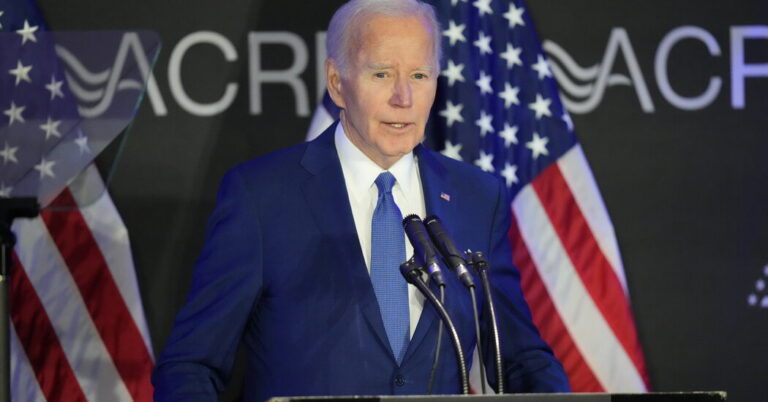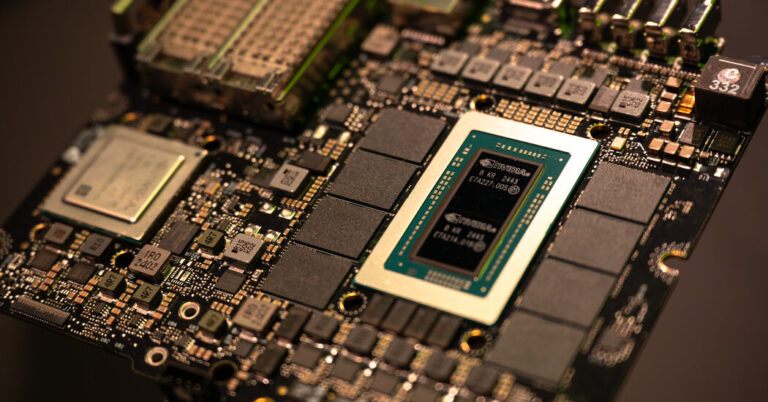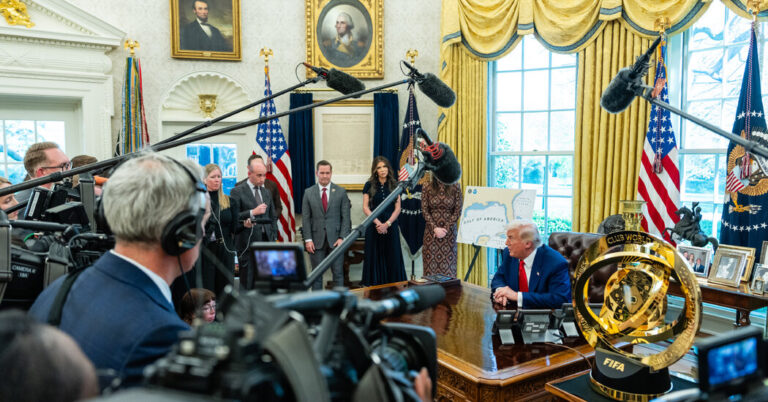Nathali Sánchez last heard from her husband on March 14, when he called from a Texas detention center to say he was being deported back to Venezuela. Later that night, he texted her through a government messaging app for detainees.
“I love you,” he wrote, “soon we will be together forever.”
Her husband, Arturo Suárez Trejo, 33, a musician, had been in American custody for a month, calling every few days to assure his family that he was OK, his relatives said. Now, the couple believed they would reunite and he would finally meet his daughter, Nahiara, who had been born during his brief stint as a migrant in the United States.
But less than a day later, Mr. Suárez was shackled, loaded onto a plane and sent to a maximum-security prison in El Salvador, according to an internal government list of detainees obtained by The New York Times. Around the time Mr. Suárez was texting his wife, the Trump administration was quietly invoking the Alien Enemies Act, a sweeping wartime power that allows the government to swiftly deport citizens of an invading nation.
Mr. Suárez and 237 others, the Trump administration argued after the order became public, were all members of a Venezuelan gang called Tren de Aragua, which was “aligned with” the Venezuelan government and was “perpetrating” an invasion of the United States.
It was an extraordinary move: The act has only been invoked three times in American history, experts say — most recently in World War II, when it was used to detain German, Italian and Japanese people.
And in this case, the Venezuelan men were declared “alien enemies” and shipped to a prison with little or no opportunity to contest the allegations against them, according to migrants, their lawyers, court testimony, judges and interviews with dozens of prisoners’ families conducted by The New York Times.
The government’s public declaration of the act was made on March 15 at 3:53 p.m., according to court records. The migrants were all on flights to El Salvador by 7:36 p.m.
Yet most of the men do not have criminal records in the United States or elsewhere in the region, beyond immigration offenses, a New York Times investigation has found. And very few of them appear to have any clear, documented links to the Venezuelan gang.
As they were being expelled, the detainees repeatedly begged officials to explain why they were being deported, and where they were being taken, one of their lawyers told the courts. At no point, the lawyer said, did officers indicate that the men were being sent to El Salvador or that they were removed under the Alien Enemies Act.
The Alien Enemies Act gives the U.S. government broad powers to detain people during times of war, but Supreme Court rulings make clear that detainees have a right to challenge the government, and are entitled to a hearing, before their removal.
Last month, an appeals court judge criticized the lack of due process under the Trump administration. “Nazis got better treatment under the Alien Enemy Act,” said Judge Patricia Millett.
Then, last week, all nine Supreme Court justices said that targeted individuals must be given time to contest their removal before they’re expelled — and demanded that the Trump administration provide that opportunity going forward.
In court, the administration has argued that the men can still challenge their incarceration — but that will be difficult, if not impossible, because they are already in El Salvador, out of reach of the American justice system, with little access to lawyers or even their family members.
“They should stay there for the rest of their lives,” Kristi Noem, the homeland security secretary, said last week.
Then on Monday, President Nayib Bukele of El Salvador forcefully backed the administration during a visit to the White House. He flatly rejected the idea of returning a Maryland man who had been wrongfully deported to El Salvador, despite the Supreme Court’s instructions that the United States take steps to bring back the migrant.
The Trump administration claims that all of the 238 Venezuelan men now imprisoned in El Salvador are members of Tren de Aragua, a transnational gang born in Venezuela. Their expulsion, the administration argues, is part of its plan to deport the worst migrant offenders.
Officials say they used criminal records, social media, surveillance data, interviews with migrants and other information, like tattoos, to make their accusations.
But a Times investigation found little evidence of any criminal background — or any association with the gang — for most of the men. In fact, the prosecutors, law enforcement officials, court documents and media reports that The Times uncovered or spoke to in multiple countries suggested that only a few of the detainees might have had any connection to Tren de Aragua.
Seeking to provide a fuller picture of who was imprisoned, a team of Times reporters and researchers ran the 238 names through three U.S. public records databases, checked backgrounds in Venezuela, Colombia, Peru, Ecuador and Chile, scoured court documents and news articles, spoke to dozens of family members and interviewed experts on Tren de Aragua.
The findings are not comprehensive — there is no global public database to search for every accusation, and the U.S. government did not share its evidence against the detainees. But The Times’s investigation provides a snapshot of who the United States sent to El Salvador.
Some of the prisoners do appear to have committed grave crimes. At least 32 of the men sent to El Salvador have faced serious criminal accusations or convictions in the United States or abroad, including a man accused of participating in an assault in Chicago, another convicted of trying to smuggle arms out of the United States and others accused of theft, strangulation, domestic battery or harboring undocumented immigrants.
One has a homicide conviction in Venezuela, according to court documents. Another man was accused in Chile of kidnapping, drugging and raping a woman during a four-day rage.
Chilean prosecutors also believe the man is a member of Tren de Aragua, according to court documents. Investigators say they found his name and messages in the phones of other gang members.
Beyond that, The Times found that another two dozen of the men locked up in El Salvador had been accused or found guilty of lower-level offenses in the United States or elsewhere, including trespassing, speeding in a school zone and driving an improperly registered vehicle.
But for the others, including Mr. Suárez, the musician, The Times found no evidence of a criminal background, beyond offenses related to being unauthorized migrants. Mr. Suárez’s family presented official certificates from Venezuela, Colombia and Chile — where he lived in the past — saying he had no convictions in those nations.
All 238 men will spend at least a year in El Salvador’s Terrorism Confinement Center, a sprawling complex of concrete and barbed wire built by President Nayib Bukele, who has called himself “a dictator” and promoted the prison as a holding pen for his country’s worst criminals.
The United States is paying the government of El Salvador to incarcerate the Venezuelan prisoners. On X, the Salvadoran leader called the yearlong sentence “renewable.”
The U.S. government’s use of the alien act is now the subject of an intense court battle between the administration and civil rights groups, including the American Civil Liberties Union, whose lawyers say the government has not met the standard to invoke the measure: a war with or invasion by Venezuela.
The groups also argue the government has violated the migrants’ rights to contest the accusation that they are members of Tren de Aragua and therefore “alien enemies.”
In court, the government has said that it has broad powers to determine what constitutes a war or invasion, as well as to decide who is a member of the gang, which the administration recently designated a foreign terrorist organization.
This week, the Supreme Court said the Trump administration could continue deporting people using the Alien Enemies Act while the legal fight plays out in the courts — as long as detainees have a chance to challenge their expulsions.
In a related case, the Supreme Court this month also ordered the Trump administration to take steps to return the Maryland man, Kilmar Abrego García, whom the government conceded it had sent to El Salvador in error.
In that case, a judge found that the government had decided Mr. García was a member of another notorious gang, MS-13, on the basis of flimsy evidence.
As for the prisoners accused of belonging to Tren de Aragua, a spokeswoman for the Department of Homeland Security, Tricia McLaughlin, said that all the men sent to El Salvador are “actually terrorists, human rights abusers, gangsters and more; they just don’t have a rap sheet in the U.S.”
“We are confident in our law enforcement’s intelligence,” she added. “We have a stringent law enforcement assessment in place that abides by due process.”
The raids targeting Venezuelan migrants began just after Mr. Trump took office.
Officials from Immigration and Customs Enforcement seized Neri Alvarado, 25, a former psychology student, in a parking lot as he headed to work at a Dallas bakery, said his sister and his boss. Authorities picked up Francisco García Casique, 24, a barber, at his home in Austin, Texas, his family said. They grabbed Gustavo Aguilera Agüero, 27, an Uber driver, while he was working on his car in a driveway outside Dallas, according to his mother.
Mr. Suárez, the musician, came from a once middle-class family in Venezuela, the second oldest of seven siblings. His mother was an educator, his father a bricklayer. In 2014, he joined mass protests against the country’s authoritarian government, said his older brother, Nelson Suárez, 35, who now lives in the United States.
But when the country’s autocratic leader, Nicolás Maduro, tightened his grip and the Venezuelan economy spiraled into crisis, leaving millions hungry, the younger Mr. Suárez left for Colombia, then Chile.
“Many times we had to run for our lives,” said the older Mr. Suárez, “until we decided to leave.”
In Chile, the younger Mr. Suárez installed refrigerators and began building a following as a singer, mixing rap, hip-hop and reggaeton.
“There’s no sin here; there’s no sentence,” he sang in one song, about a woman who works the streets to escape poverty.
He met his wife, Ms. Sánchez, at a music event.
In the United States, Mr. Suárez believed he could advance his music career, said his brother, and make money to send back to his growing family.
He entered the United States on Sept. 3 using a Biden-era application that allowed people to present themselves at the border and ask for entry, according to documents reviewed by The Times. Officials allowed him in with an order to appear in court on March 6, where he would have the opportunity to fight removal.
In North Carolina, he worked in landscaping, said his brother Nelson.
On Dec. 2, his daughter was born in Chile.
On Jan. 20, Mr. Trump became president.
On Feb. 8, Mr. Suárez arrived at a house in Raleigh to record a music video. But U.S. immigration agents showed up and hauled him away, according to the brother.
Soon, Mr. Suárez was in detention in Georgia, where he told his brother that an official had done a background check and reviewed his YouTube channel. Mr. Suárez told his brother that officials didn’t seem to believe he was guilty of anything more than being a migrant.
“If this had been another moment, they would have let him go,” the brother said Mr. Suárez told him. “But since we are in this madness he was going to stay in the hands of ICE”
In dozens of interviews, family members said that once the men were detained, U.S. officials focused on their tattoos.
Mr. García, the barber, had the word “peace” written on his neck, accompanied by a crown, and had the names of his mother, grandmother and sisters on his body, said his family.
Mr. Aguilera, the Uber driver, had the name of his oldest son, Santiago, also accompanied by a crown, a star, a skull with flowers and the infinity symbol, according to his mother.
Mr. Alvarado, the former psychology student, had come to the United States to earn money to help his younger brother, who has autism, other disabilities and health problems, his family said.
Before leaving, Mr. Alvarado had inked on his leg a rainbow ribbon associated with autism awareness. His sister said it went with Mr. Alvarado’s other tattoos, which read: “brothers,” “family” and “self love.”
In an interview, Mr. Trump’s border czar, Tom Homan, said tattoos were just one factor used to determine if an individual was a member of Tren de Aragua.
“I don’t say it’s a major factor,” he said, “it’s one of many.”
But an internal government document made public in court filings indicates how much weight is given to tattoos.
The document, called the “Alien Enemy Validation Guide,” instructs immigration officials to use a point system to identify members of Tren de Aragua. Eight points makes someone a “validated” member of the group. Having tattoos associated with the gang is worth four points.
Wearing clothing associated with the gang is worth another four.
A second government document indicates that the administration considers a crown tattoo — much like the one worn by soccer star Lionel Messi — and the “Jump Man” symbol, popularized by Michael Jordan, to be Tren de Aragua symbols.
Clothing associated with the gang includes “high-end urban street wear.”
In interviews, five Venezuelan experts on Tren de Aragua — two police officials, two scholars and a journalist — told The Times that while some transnational gangs use tattoos as indicators of membership, the Venezuelan group did not.
“In the case of the Tren de Aragua,” said Luis Izquiel, a professor of criminology at Venezuela’s Central University, “there is no common pattern of similar tattoos among its members.”
While many Tren de Aragua members have tattoos, experts said, so do many young Venezuelan men.
Of the 30 men whose family members or lawyers spoke to the Times, at least 27 have tattoos.
Mr. Suárez has 33, said his family, reflecting his urban music aesthetic. They include one of his signature phrases, they said: “The future is bright.”
The Trump administration began to move dozens of detained Venezuelan men to facilities in Texas roughly two weeks before invoking the Alien Enemies Act.
On March 14 and 15, the men called their families to say that Americans officials had told them they were being deported back to Venezuela, according to dozens of interviews.
In Aragua state, in Venezuela, Mirelis Casique, the mother of Mr. García, the barber, rushed to fix up his room, applying new paint and hanging new curtains.
But by March 16, the wife of Mr. Suárez, the musician, had still not heard from him.
Her anxiety rising, she turned to Google.
“Deportation to Venezuela,” she typed into the search box.
By now, three flights carrying the 238 men had arrived in El Salvador, despite a judge’s order that the Trump administration turn them around.
That morning, Mr. Bukele had posted a video showing the new prisoners shackled and gripped by guards in riot gear being led into the prison.
“We removed terrorists,” Mr. Homan, the U.S. border czar, said from Washington. “That should be a celebration in this country.”
Online, Mr. Suárez’s wife pulled up an image of a sea of shaved, cuffed men in Salvadoran prison. She recognized one: It was her husband.
Holding her newborn, she sat down and cried.
Later, she logged in to an online ICE search page that had allowed her to track her husband’s whereabouts in the United States.
Mr. Suárez had suddenly disappeared from the system.
Never before, legal analysts say, has the Alien Enemies Act been used with such little due process.
During World War II, the Department of Justice established civilian hearing boards in which “registered aliens” of German, Italian and Japanese descent arrested by the government could argue they were not a danger to the nation, legal scholars said.
Many scholars have criticized that process as deeply flawed; detainees were not afforded lawyers and could still be held based on hearsay and bias or racial discrimination.
But Eric L. Muller, a professor at the University of North Carolina School of Law, said they nevertheless provided “a check” on the government, adding that the majority of people who obtained a hearing under the civilian boards were released.
In Venezuela, families have gathered for marches calling for the release of loved ones. Many have tried contacting American and Salvadoran officials, but say their messages have gone unanswered.
The governments of Mr. Trump and Mr. Bukele have refused to release a list of the men confined in the terrorism center or to confirm to families who is there.
For this article, The Times obtained an internal government list of names. CBS News previously reported the names.
The White House has said that 137 of the men were deported under the Alien Enemies Act, while 101 others were expelled under normal immigration proceedings. All are accused of being gang members, and all are in prison in El Salvador.
In recent weeks, Venezuela’s autocratic leader has accused the Trump administration of engaging in a violation with a long grim history in Latin America: a large-scale “forced disappearance.”
The United Nations defines the practice as the deprivation of liberty “followed by a refusal to disclose the fate or whereabouts of the persons concerned.”
In a rare moment of agreement, Human Rights Watch has come to the same conclusion as the Venezuelan leader.
Mr. Suárez’s brother says his biggest fear is that “tomorrow I get my brother back — in a wooden box.”
An uncle of Mr. Suárez’s, Edgar Trejo, said the family had been struggling not only to understand how the musician ended up in a faraway prison, but also the turn of events in “a country as organized and as just” as the United States.
Once upon a time, said Mr. Trejo, a pastor in Caracas, he believed that the United States was “God’s policeman on earth.”
In Caracas, the family had become accustomed to people being carted away with no trial.
Now, he said, “what we have seen here,” in Venezuela “we are also seeing there.”
Research was contributed by Alain Delaquérière, Susan C. Beachy, Kirsten Noyes and Sheelagh McNeill. Reporting was contributed by Pascale Bonnefoy, Sheyla Urdaneta, Mitra Taj, Alan Feuer, Steven Rich, José María León Cabrera, Annie Correal, Miriam Jordan,Luis Ferré-Sadurní, Ana Ley, Genevieve Glatsky and Simón Posada.
Audio produced by Jack D’Isidoro.













